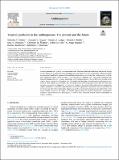Files in this item
Tropical peatlands in the Anthropocene : the present and the future
Item metadata
| dc.contributor.author | Girkin, Nicholas T. | |
| dc.contributor.author | Cooper, Hannah V. | |
| dc.contributor.author | Ledger, Martha J. | |
| dc.contributor.author | O’Reilly, Patrick | |
| dc.contributor.author | Thornton, Sara A. | |
| dc.contributor.author | Åkesson, Christine | |
| dc.contributor.author | Cole, Lydia E.S. | |
| dc.contributor.author | Hapsari, K. Anggi | |
| dc.contributor.author | Hawthorne, Donna | |
| dc.contributor.author | Roucoux, Katherine H. | |
| dc.date.accessioned | 2022-12-02T16:30:19Z | |
| dc.date.available | 2022-12-02T16:30:19Z | |
| dc.date.issued | 2022-12-01 | |
| dc.identifier | 282240800 | |
| dc.identifier | c126a41e-cb0d-492c-a71d-a1c1c55b69b4 | |
| dc.identifier | 85143157167 | |
| dc.identifier.citation | Girkin , N T , Cooper , H V , Ledger , M J , O’Reilly , P , Thornton , S A , Åkesson , C , Cole , L E S , Hapsari , K A , Hawthorne , D & Roucoux , K H 2022 , ' Tropical peatlands in the Anthropocene : the present and the future ' , Anthropocene , vol. 40 , 100354 . https://doi.org/10.1016/j.ancene.2022.100354 | en |
| dc.identifier.issn | 2213-3054 | |
| dc.identifier.other | RIS: urn:FE3A1DA3F224ABFE0242F0BD27FF0F44 | |
| dc.identifier.other | ORCID: /0000-0001-6757-7267/work/124078586 | |
| dc.identifier.other | ORCID: /0000-0002-1442-7019/work/124079001 | |
| dc.identifier.other | ORCID: /0000-0003-3198-6311/work/124079103 | |
| dc.identifier.uri | https://hdl.handle.net/10023/26535 | |
| dc.description | Funding: This work was supported by the Natural Environment Research Council (Grant No. NE/R016860/1 and NE/R000751/1), the German Research Foundation (BE 2116/32-1) for funding KAH; the Newton-Paulet Institutional Links Grant (Grant ref. 220–2018) for part-funding KHR and LESC, and to the Leverhulme Trust for part-funding LESC (Research Grant RPG-2018-306). | en |
| dc.description.abstract | Tropical peatlands are a globally important carbon store. They host significant biodiversity and provide a range of other important ecosystem services, including food and medicines for local communities. Tropical peatlands are increasingly modified by humans in the rapid and transformative way typical of the “Anthropocene,” with the most significant human—driven changes to date occurring in Southeast Asia. This review synthesizes the dominant changes observed in human interactions with tropical peatlands in the last 200 years, focusing on the tropical lowland peatlands of Southeast Asia. We identify the beginning of transformative anthropogenic processes in these carbon-rich ecosystems, chart the intensification of these processes in the 20th and early 21st centuries, and assess their impacts on key ecosystem services in the present. Where data exist, we compare the tropical peatlands of Central Africa and Amazonia, which have experienced very different scales of disturbance in the recent past. We explore their global importance and how environmental pressures may affect them in the future. Finally, looking to the future, we identify ongoing efforts in peatland conservation, management, restoration, and socio-economic development, as well as areas of fruitful research toward sustainability of tropical peatlands. | |
| dc.format.extent | 16 | |
| dc.format.extent | 5871239 | |
| dc.language.iso | eng | |
| dc.relation.ispartof | Anthropocene | en |
| dc.subject | Tropical peatlands | en |
| dc.subject | Land use change | en |
| dc.subject | Palm oil | en |
| dc.subject | Climate change | en |
| dc.subject | Biodiversity | en |
| dc.subject | Carbon cycle | en |
| dc.subject | GE Environmental Sciences | en |
| dc.subject | QE Geology | en |
| dc.subject | T-DAS | en |
| dc.subject | SDG 3 - Good Health and Well-being | en |
| dc.subject | SDG 8 - Decent Work and Economic Growth | en |
| dc.subject | SDG 13 - Climate Action | en |
| dc.subject | SDG 15 - Life on Land | en |
| dc.subject | MCC | en |
| dc.subject.lcc | GE | en |
| dc.subject.lcc | QE | en |
| dc.title | Tropical peatlands in the Anthropocene : the present and the future | en |
| dc.type | Journal article | en |
| dc.contributor.sponsor | NERC | en |
| dc.contributor.sponsor | NERC | en |
| dc.contributor.sponsor | The Leverhulme Trust | en |
| dc.contributor.institution | University of St Andrews. Environmental Change Research Group | en |
| dc.contributor.institution | University of St Andrews. School of Geography & Sustainable Development | en |
| dc.contributor.institution | University of St Andrews. Centre for Energy Ethics | en |
| dc.identifier.doi | https://doi.org/10.1016/j.ancene.2022.100354 | |
| dc.description.status | Peer reviewed | en |
| dc.identifier.grantnumber | NE/R016860/1 | en |
| dc.identifier.grantnumber | NE/R000751/1 | en |
| dc.identifier.grantnumber | RPG-2018-306 | en |
This item appears in the following Collection(s)
Items in the St Andrews Research Repository are protected by copyright, with all rights reserved, unless otherwise indicated.

